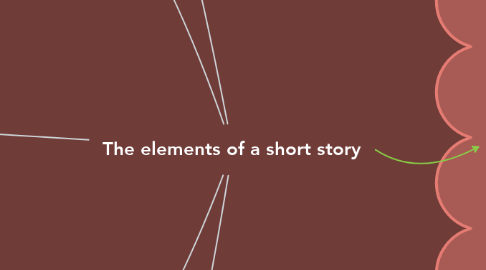
1. Setting
1.1. The setting creates the atmosphere of the story, it is the place and the time where the story is developed.
1.1.1. Examples
1.1.1.1. Place: in the park,
1.1.1.2. Time: last Christmas
2. Plot
2.1. It is what happens in the story. I t shows the sequence of the different events.
2.1.1. it is divided in 5 parts which are:
2.1.1.1. Exposition
2.1.1.1.1. It is the introduction, the characters are introduced, the setting is established, and it is introduced the primary conflict of the story.
2.1.1.2. Rising action
2.1.1.2.1. The rising action normally begins with an inciting incident, or a moment that sets your story into action.
2.1.1.3. Climax
2.1.1.3.1. This is the point in the story that everything changes, or where the main character is forced to make a life-altering decision.
2.1.1.4. Falling action
2.1.1.4.1. It is when the conflict can start being resolved. It happens instantly after the climax.
2.1.1.5. Resolution or ending
2.1.1.5.1. At this point, the story can tie up the final loose ends and bring a happy or tragic ending.
3. Characters
3.1. They illustrate the story through characterization or SAT ( speech, actions, and thoughts) . There are 6 types
3.1.1. Protagonist
3.1.1.1. Often the stories are narrated from their point of view. It is the main character of the story and generally the good one.
3.1.2. Antagonist
3.1.2.1. It is the villain of the story.
3.1.3. Static
3.1.3.1. Also known as "flat character", does not change over the course of a story.
3.1.4. Dynamic
3.1.4.1. It is character who changes over the course of the story. Today can be good, tomorrow can be bad.
3.1.5. Round
3.1.5.1. They show fluidity and the capacity for change from the moment we meet them. They are difficult to describe due to their many qualities and emotions
3.1.6. Flat
3.1.6.1. It is easy to describe because possess few traits.
4. Conflict
4.1. It is the situation or problem that the main character most solve. There are 2 types of conflicts
4.1.1. Internal
4.1.1.1. It is when a character struggles with their own opposing desires or belief.
4.1.2. External
4.1.2.1. It sets a character against something or someone beyond their control.
4.1.2.1.1. Examples
5. Theme
5.1. It is what a story all about. It can present a moral or lesson.
6. Fact: they are regularly mistaken for anti heroes who are villainous people who function in a protagonist’s role.
7. The implications of the author's point of view
7.1. First-Person
7.1.1. In the first-person narrative, the narrator is part of the story. This point of view it is often describe by the pronouns "I" or "we"
7.2. Second-Person
7.2.1. The second-person narration is usually used for instructions. Here the pronoun "you" is commonly used to represent "your" perspective.
7.3. Third-Person
7.3.1. In the third-person narrative, the narrator is not involved in the story. This type of narration tells other's stories. There are three types of Third-person narration
7.3.1.1. Third-Person Omniscient
7.3.1.1.1. The omniscient narrator knows everything about the story and its characters. This narrator can enter anyone’s mind, move freely through time, and give the reader their own opinions and observations as well as those of the characters.
7.3.1.2. Third-person limited
7.3.1.2.1. This point of view allows the author to limit a reader’s perspective and control what information the reader knows.
7.3.1.3. Third-person objective
7.3.1.3.1. It has a neutral narrator that is not privy to characters’ thoughts or feelings.
